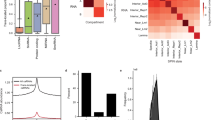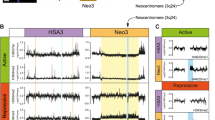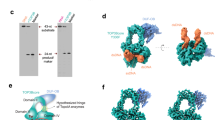Abstract
We have previously reported that the human ACAT1 gene produces a chimeric mRNA through the interchromosomal processing of two discontinuous RNAs transcribed from chromosomes 1 and 7. The chimeric mRNA uses AUG1397-1399 and GGC1274-1276 as translation initiation codons to produce normal 50-kDa ACAT1 and a novel enzymatically active 56-kDa isoform, respectively, with the latter being authentically present in human cells, including human monocyte-derived macrophages. In this work, we report that RNA secondary structures located in the vicinity of the GGC1274-1276 codon are required for production of the 56-kDa isoform. The effects of the three predicted stem-loops (nt 1255-1268, 1286-1342 and 1355-1384) were tested individually by transfecting expression plasmids into cells that contained the wild-type, deleted or mutant stem-loop sequences linked to a partial ACAT1 AUG open reading frame (ORF) or to the ORFs of other genes. The expression patterns were monitored by western blot analyses. We found that the upstream stem-loop1255-1268 from chromosome 7 and downstream stem-loop1286-1342 from chromosome 1 were needed for production of the 56-kDa isoform, whereas the last stem-loop1355-1384 from chromosome 1 was dispensable. The results of experiments using both monocistronic and bicistronic vectors with a stable hairpin showed that translation initiation from the GGC1274-1276 codon was mediated by an internal ribosome entry site (IRES). Further experiments revealed that translation initiation from the GGC1274-1276 codon requires the upstream AU-constituted RNA secondary structure and the downstream GC-rich structure. This mechanistic work provides further support for the biological significance of the chimeric nature of the human ACAT1 transcript.
Similar content being viewed by others
Log in or create a free account to read this content
Gain free access to this article, as well as selected content from this journal and more on nature.com
or
References
Chang TY, Chang CC, Cheng D . Acyl-coenzyme A:cholesterol acyltransferase. Annu Rev Biochem 1997; 66:613–638.
Yu C, Chen J, Lin S, et al. Human acyl-CoA:cholesterol acyltransferase-1 is a homotetrameric enzyme in intact cells and in vitro. J Biol Chem 1999; 274:36139–36145.
Rudel LL, Lee RG, Cockman TL . Acyl coenzyme A: cholesterol acyltransferase types 1 and 2: structure and function in atherosclerosis. Curr Opin Lipidol 2001; 12:121–127.
Chang TY, Chang CC, Lin S, et al. Roles of acyl-coenzyme A:cholesterol acyltransferase-1 and -2. Curr Opin Lipidol 2001; 12:289–296.
Song BL, Wang CH, Yao XM, et al. Human acyl-CoA:cholesterol acyltransferase 2 gene expression in intestinal Caco-2 cells and in hepatocellular carcinoma. Biochem J 2006; 394:617–626.
Yang JB, Duan ZJ, Yao W, et al. Synergistic transcriptional activation of human Acyl-coenzyme A: cholesterol acyltransterase-1 gene by interferon-gamma and all-trans-retinoic acid THP-1 cells. J Biol Chem 2001; 276:20989–20998.
Yang L, Yang JB, Chen J, et al. Enhancement of human ACAT1 gene expression to promote the macrophage-derived foam cell formation by dexamethasone. Cell Res 2004; 14:315–323.
Chang C, Dong R, Miyazaki A, et al. Human acyl-CoA:cholesterol acyltransferase (ACAT) and its potential as a target for pharmaceutical intervention against atherosclerosis. Acta Biochim Biophys Sin 2006; 38:151–156.
Chang CC, Huh HY, Cadigan KM, Chang TY . Molecular cloning and functional expression of human acyl-coenzyme A:cholesterol acyltransferase cDNA in mutant Chinese hamster ovary cells. J Biol Chem 1993; 268:20747–20755.
Li BL, Li XL, Duan ZJ, et al. Human acyl-CoA:cholesterol acyltransferase-1 (ACAT-1) gene organization and evidence that the 4.3-kilobase ACAT-1 mRNA is produced from two different chromosomes. J Biol Chem 1999; 274:11060–11071.
Kozak M . Regulation of translation via mRNA structure in prokaryotes and eukaryotes. Gene 2005; 361:13–37.
Huez I, Creancier L, Audigier S, et al. Two independent internal ribosome entry sites are involved in translation initiation of vascular endothelial growth factor mRNA. Mol Cell Biol 1998; 18:6178–6190.
Sasaki J, Nakashima N . Methionine-independent initiation of translation in the capsid protein of an insect RNA virus. Proc Natl Acad Sci USA 2000; 97:1512–1515.
Burge CB, Tuschl T, Sharp PA . Splicing of precursors to mRNAs by the spliceosome. New York: Cold Spring Harbor Laboratory Press, 1999.
Krainer AR . Eukaryotic mRNA processing. New York: Oxford University Press, 1997.
Yang L, Chen J, Chang CC, et al. A stable upstream stem-loop structure enhances selection of the first 5′-ORF-AUG as a main start codon for translation initiation of human ACAT1 mRNA. Acta Biochim Biophys Sin 2004; 36:259–268.
Yang L, Lee O, Chen J, et al. Human acyl-coenzyme A:cholesterol acyltransferase 1 (acat1) sequences located in two different chromosomes (7 and 1) are required to produce a novel ACAT1 isoenzyme with additional sequence at the N terminus. J Biol Chem 2004; 279:46253–46262.
Vagner S, Waysbort A, Marenda M, et al. Alternative translation initiation of the Moloney murine leukemia virus mRNA controlled by internal ribosome entry involving the p57/PTB splicing factor. J Biol Chem 1995; 270:20376–20383.
Yang DQ, Halaby MJ, Zhang Y . The identification of an internal ribosomal entry site in the 5′-untranslated region of p53 mRNA provides a novel mechanism for the regulation of its translation following DNA damage. Oncogene 2006; 25:4613–4619.
Dhar D, Roy S, Das S . Translational control of the interferon regulatory factor 2 mRNA by IRES element. Nucleic Acids Res 2007; 35:5409–5421.
Pestova TV, Shatsky IN, Fletcher SP, Jackson RJ, Hellen CU . A prokaryotic-like mode of cytoplasmic eukaryotic ribosome binding to the initiation codon during internal translation initiation of hepatitis C and classical swine fever virus RNAs. Genes Dev 1998; 12:67–83.
Gebauer F, Hentze MW . Molecular mechanisms of translational control. Nat Rev Mol Cell Biol 2004; 5:827–835.
Rijnbrand R, Bredenbeek PJ, Haasnoot PC, et al. The influence of downstream protein-coding sequence on internal ribosome entry on hepatitis C virus and other flavivirus RNAs. RNA 2001; 7:585–597.
Pestova TV, Hellen CU, Shatsky IN . Canonical eukaryotic initiation factors determine initiation of translation by internal ribosomal entry. Mol Cell Biol 1996; 16:6859–6869.
Pestova TV, Shatsky IN, Hellen CU . Functional dissection of eukaryotic initiation factor 4F: the 4A subunit and the central domain of the 4G subunit are sufficient to mediate internal entry of 43S preinitiation complexes. Mol Cell Biol 1996; 16:6870–6878.
Hellen CU, Witherell GW, Schmid M, et al. A cytoplasmic 57-kDa protein that is required for translation of picornavirus RNA by internal ribosomal entry is identical to the nuclear pyrimidine tract-binding protein. Proc Natl Acad Sci USA 1993; 90:7642–7646.
Walter BL, Nguyen JH, Ehrenfeld E, Semler BL . Differential utilization of poly(rC) binding protein 2 in translation directed by picornavirus IRES elements. RNA 1999; 5:1570–1585.
Buratti E, Baralle FE . Influence of RNA secondary structure on the pre-mRNA splicing process. Mol Cell Biol 2004; 24:10505–10514.
Wu C, Alwine JC . Secondary structure as a functional feature in the downstream region of mammalian polyadenylation signals. Mol Cell Biol 2004; 24:2789–2796.
Linnstaedt SD, Kasprzak WK, Shapiro BA, Casey JL . The role of a metastable RNA secondary structure in hepatitis delta virus genotype III RNA editing. RNA 2006; 12:1521–1533.
Cadigan KM, Heider JG, Chang TY . Isolation and characterization of Chinese hamster ovary cell mutants deficient in acyl-coenzyme A:cholesterol acyltransferase activity. J Biol Chem 1988; 263:274.
Higuchi R, Krummel B, Saiki RK . A general method of in vitro preparation and specific mutagenesis of DNA fragments: study of protein and DNA interactions. Nucleic Acids Res 1988; 16:7351–7367.
Kozak M . Circumstances and mechanisms of inhibition of translation by secondary structure in eucaryotic mRNAs. Mol Cell Biol 1989; 9:5134–5142.
Chang CC, Chen J, Thomas MA, et al. Regulation and immunolocalization of acyl-coenzyme A: cholesterol acyltransferase in mammalian cells as studied with specific antibodies. J Biol Chem 1995; 270:29532–29540.
Zuker M . Mfold web server for nucleic acid folding and hybridization prediction. Nucleic Acids Res 2003; 31:3406–3415.
Sambrook J, Fritsch EF, Maniatis T . Molecular Cloning. 2nd Edition. New York: Cold Spring Harbor Laboratory Press, 1989.
Acknowledgements
This work was supported by grants from the National Basic Research Program of China (No. 2002CB513003, 2006CB0D1100) and the Hi-Tech Research and Development Program of China (No. 2007AA09Z400), Foundations NNSC (No. 30571057) and SSTC (No. 07JC14061) to Bo-Liang Li, Bao-Liang Song and Ying Xiong, and NIH grant HL 36709 to Ta Yuan Chang. We thank Dr Kang-Cheng Ruan and our colleagues Lei Lei, Jia-Jia Xu, and Qin Li for helpful discussion and technical assistance during the course of this study. We thank Prof Akio Nomoto for the plasmid pC1B that contains the HCV IRES.
Author information
Authors and Affiliations
Corresponding author
Rights and permissions
About this article
Cite this article
Chen, J., Zhao, XN., Yang, L. et al. RNA secondary structures located in the interchromosomal region of human ACAT1 chimeric mRNA are required to produce the 56-kDa isoform. Cell Res 18, 921–936 (2008). https://doi.org/10.1038/cr.2008.66
Received:
Revised:
Accepted:
Published:
Issue date:
DOI: https://doi.org/10.1038/cr.2008.66



